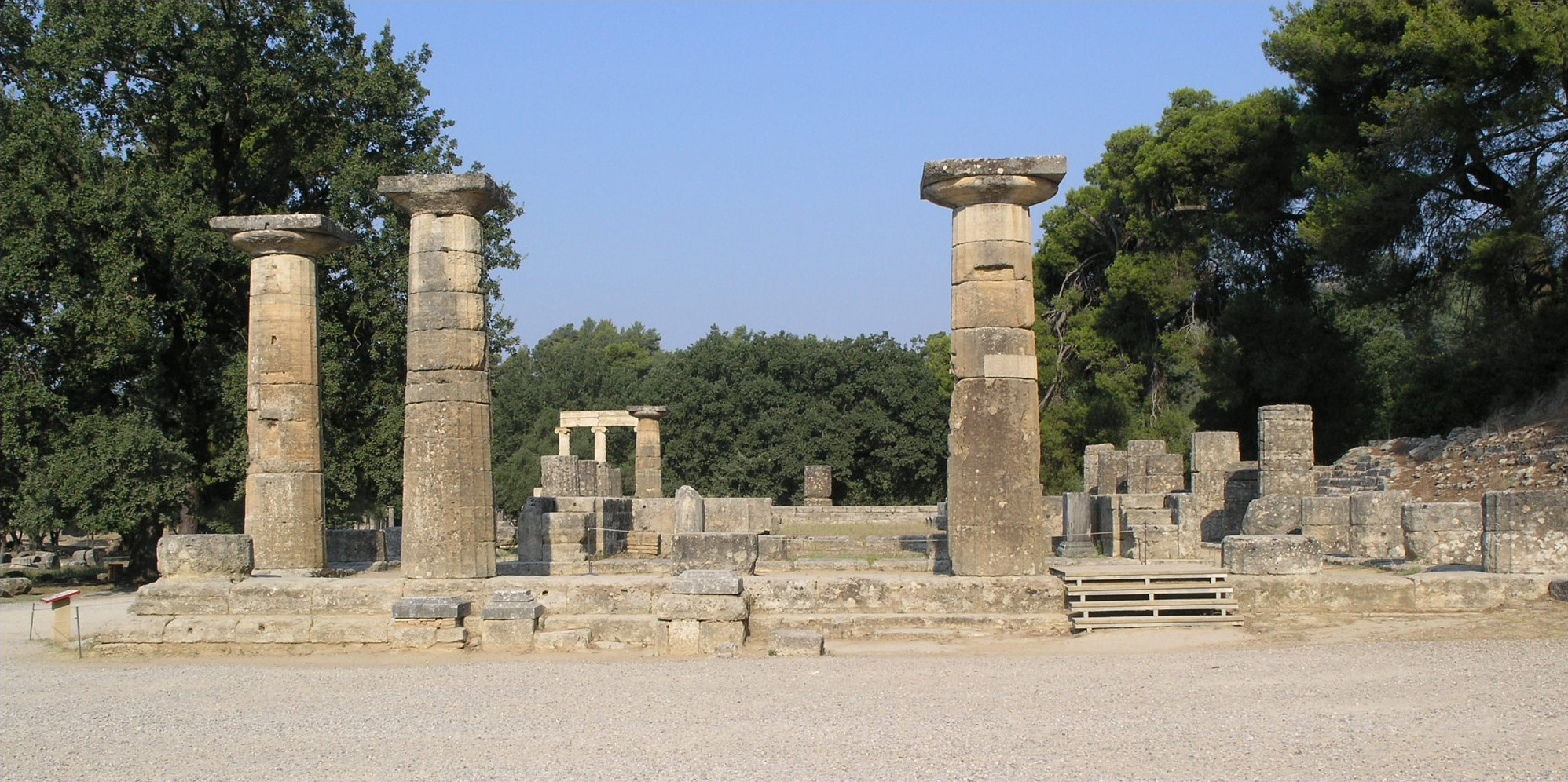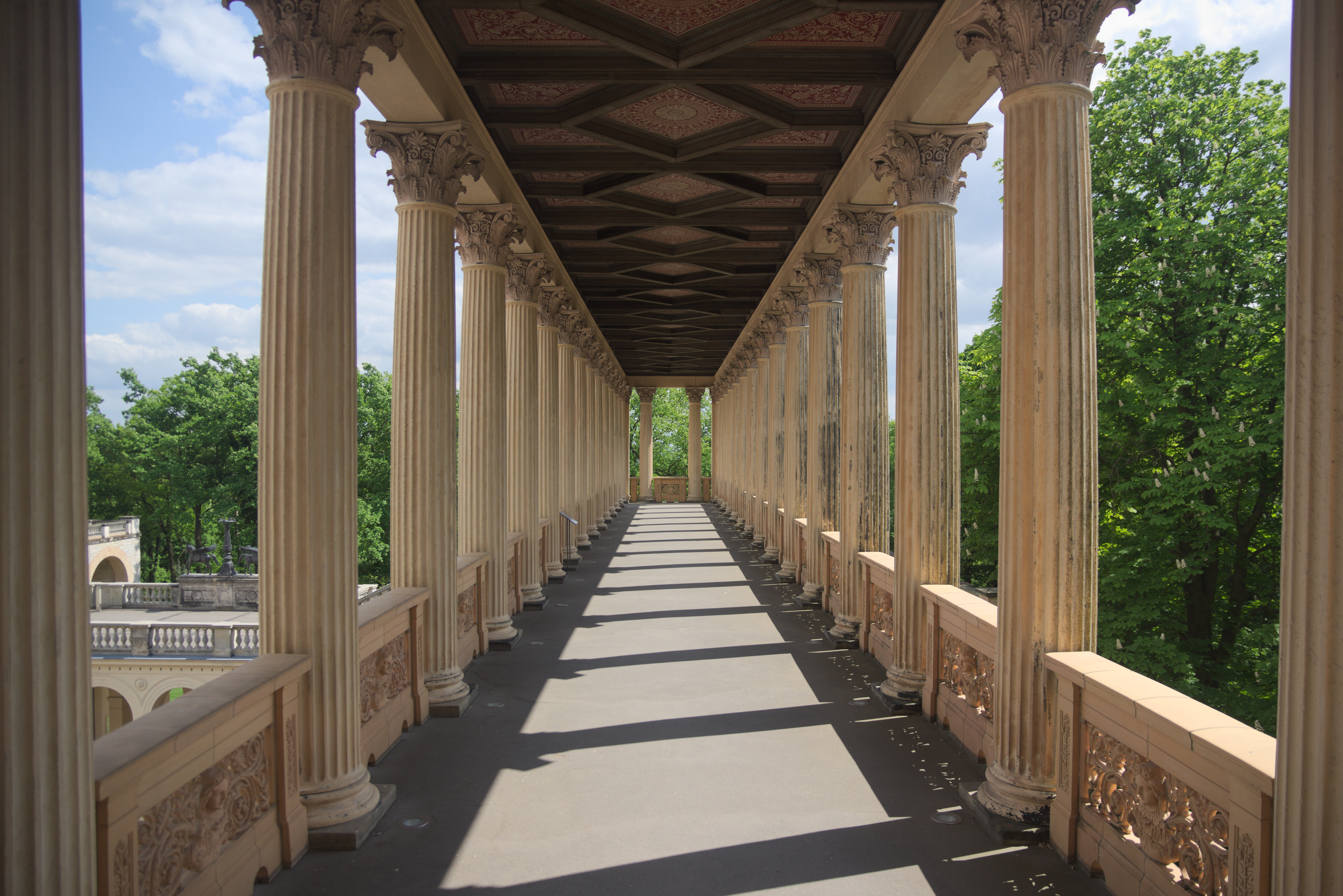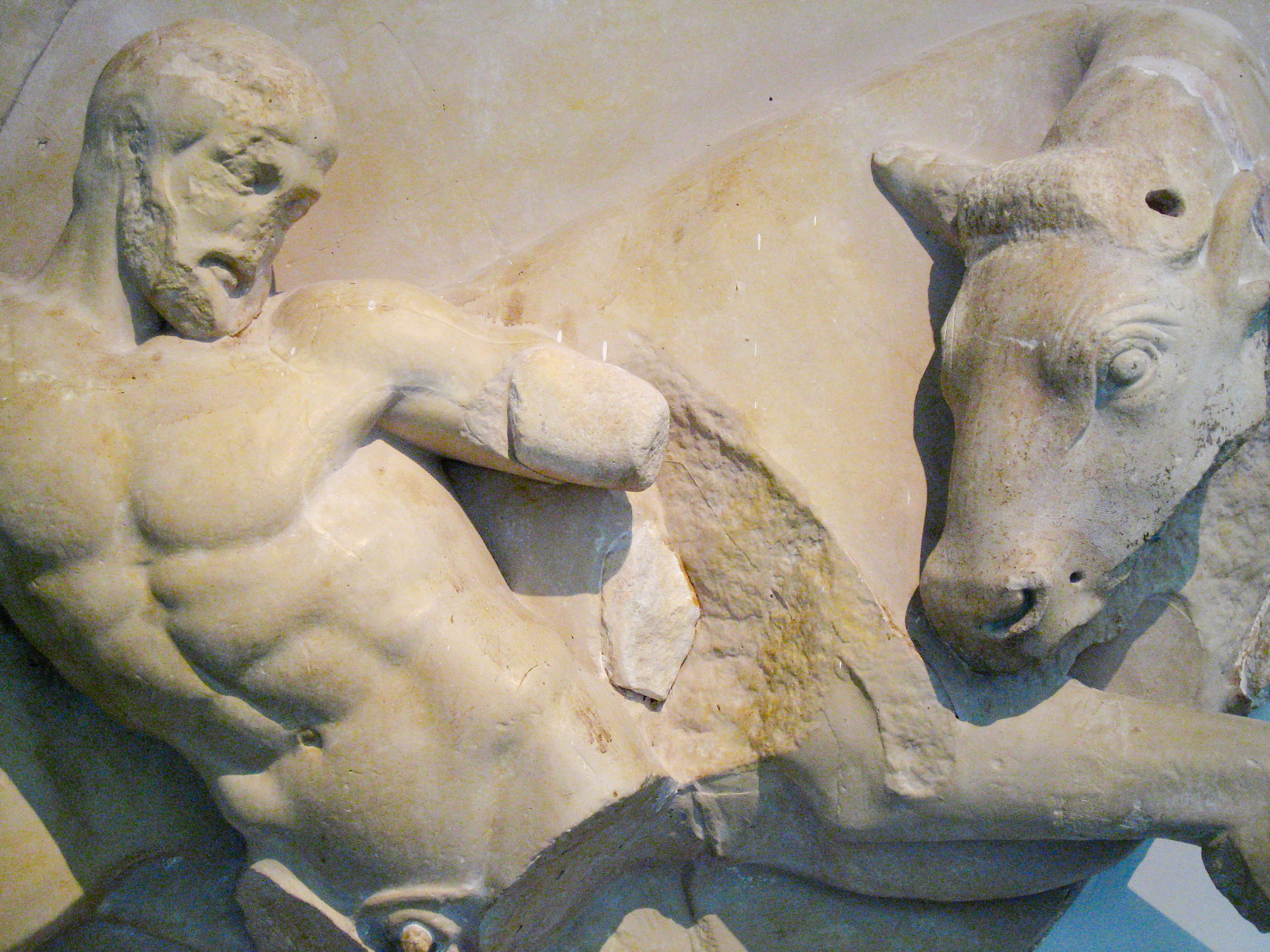|
Temple Of Hera (Olympia)
The Temple of Hera, or Heraion, is an ancient Archaic Greece, Archaic Greek temple at Olympia, Greece, Olympia, Greece, that was dedicated to Hera, queen of the Twelve Olympians, Greek gods. It is the oldest temple at Olympia and one of the most venerable in all Ancient Greece, Greece. It was originally a joint temple of Hera and Zeus, chief of the gods, until a separate temple was built for him. It is at the altar of this temple, which is oriented east-west, that the Olympic flame is lit and carried to all parts of the world. The torch of the Olympic flame is lit in its ruins to this day. The temple was built in ca. 580 BC, but was destroyed by an earthquake in the early 4th century AD. History The Heraion at Olympia, located in the north of the sacred precinct, the ''Altis'', is one of the earliest Doric order, Doric temples in Greece, and the oldest Peripteros, peripteral temple at that site, having a single row of columns on all sides. The location may have previousl ... [...More Info...] [...Related Items...] OR: [Wikipedia] [Google] [Baidu] |
Olympia - Temple Of Hera 3
Olympia may refer to: Arts and entertainment Film * Olympia (1938 film), ''Olympia'' (1938 film), by Leni Riefenstahl, documenting the Berlin-hosted Olympic Games * Olympia (1998 film), ''Olympia'' (1998 film), about a Mexican soap opera star who pursues a career as an athlete * Olympia (2011 film), ''Olympia'' (2011 film), about an aspiring porn actress * Olympia (2018 drama film), ''Olympia'' (2018 drama film), an American romantic drama * Olympia (2018 documentary film), ''Olympia'' (2018 documentary film), about the career of Academy Award-winning actress Olympia Dukakis Music * Olympia (musician), Australian art-pop singer-songwriter-guitarist Olivia Jayne Bartley (born 1982) * Olympia (Bryan Ferry album), ''Olympia'' (Bryan Ferry album) * Olympia (Austra album), ''Olympia'' (Austra album) * Olympia (EP), an EP by The Maybes? * Olympia (song), "Olympia" (song), a song by Sergio Mendes Other arts and entertainment * Olympia (Manet), ''Olympia'' (Manet), an 1863 oil on canvas ... [...More Info...] [...Related Items...] OR: [Wikipedia] [Google] [Baidu] |
Triphylia
Triphylia (, ''Trifylia'', "the country of the three tribes") was an area of the ancient Peloponnese. Strabo and Pausanias both describe Triphylia as part of Elis, and it fell at times under the domination of the city of Elis, but Pausanias claims that the residents reckoned themselves Arcadian, not Elean. They fell under the rule of Elis in the 8th century BC, and remained under Elean rule until the Spartans asserted their control in 402 BC. When the Spartans were defeated by the Thebans at the Battle of Leuctra in 371 BC, the Eleans attempted to reassert their control, but the Triphylians, in order to maintain their independence from Elis, joined the Arcadian League in 368 BC. In this period, their political fortunes were often shared by the areas on the border between Elis and Arcadia but in to the north of the River Alpheus; Xenophon mentions the Amphidolians and Acrorians and the city-states of Lasion, Margana, and Letrini in this context. The Amphidolians, Marga ... [...More Info...] [...Related Items...] OR: [Wikipedia] [Google] [Baidu] |
Capital (architecture)
In architecture, the capital () or chapiter forms the topmost member of a column (or a pilaster). It mediates between the column and the load thrusting down upon it, broadening the area of the column's supporting surface. The capital, projecting on each side as it rises to support the abacus, joins the usually square abacus and the usually circular shaft of the column. The capital may be convex, as in the Doric order; concave, as in the inverted bell of the Corinthian order; or scrolling out, as in the Ionic order. These form the three principal types on which all capitals in the classical tradition are based. The Composite order was formalized in the 16th century following Roman Imperial examples such as the Arch of Titus in Rome. It adds Ionic volutes to Corinthian acanthus leaves. From the highly visible position it occupies in all colonnaded monumental buildings, the capital is often selected for ornamentation; and is often the clearest indicator of the architec ... [...More Info...] [...Related Items...] OR: [Wikipedia] [Google] [Baidu] |
Ancient Rome
In modern historiography, ancient Rome is the Roman people, Roman civilisation from the founding of Rome, founding of the Italian city of Rome in the 8th century BC to the Fall of the Western Roman Empire, collapse of the Western Roman Empire in the 5th century AD. It encompasses the Roman Kingdom (753–509 BC), the Roman Republic (50927 BC), and the Roman Empire (27 BC476 AD) until the fall of the western empire. Ancient Rome began as an Italic peoples, Italic settlement, traditionally dated to 753 BC, beside the River Tiber in the Italian peninsula. The settlement grew into the city and polity of Rome, and came to control its neighbours through a combination of treaties and military strength. It eventually controlled the Italian Peninsula, assimilating the Greece, Greek culture of southern Italy (Magna Graecia) and the Etruscans, Etruscan culture, and then became the dominant power in the Mediterranean region and parts of Europe. At its hei ... [...More Info...] [...Related Items...] OR: [Wikipedia] [Google] [Baidu] |
Opisthodomos
An opisthodomos (ὀπισθόδομος, 'back room') is either the rear room of an ancient Greek temple or to the inner shrine, also called the adyton ('not to be entered'). The confusion arises from the lack of agreement in ancient inscriptions. In modern scholarship, it usually refers to the rear porch of a temple. On the Athenian Acropolis especially, the opisthodomos came to be a treasury, where the revenues and precious dedications of the temple were kept. Its use in antiquity was not standardised. In part because of the ritual secrecy of such inner spaces, it is not known exactly what took place within opisthodomoi; it can safely be assumed that practice varied widely by place, date and particular temple. Architecturally, the opisthodomos (as a back room) balances the pronaos or porch of a temple, creating a plan with diaxial symmetry. The upper portion of its outer wall could be decorated with a frieze, as on the Hephaisteion and the Parthenon. Opisthodomoi are pre ... [...More Info...] [...Related Items...] OR: [Wikipedia] [Google] [Baidu] |
Restored Ruins Of The Temple Of Hera, Ancient Doric Greek Temple At Olympia, Greece (16187895658)
''Restored'' is the fourth studio album by American contemporary Christian musician Jeremy Camp. It was released on November 16, 2004, by BEC Recordings. Track listing Standard release Enhanced edition Deluxe gold edition Standard Australian release Personnel * Jeremy Camp – lead and backing vocals, acoustic guitar (1–3, 5–8, 10, 12) * Andy Dodd – keyboards and programming (1, 3, 7, 9, 10, 12), electric guitar (1, 3, 7, 9, 10, 12) * Adam Watts – keyboards and programming (1, 3, 9), drums (1, 3, 7, 9, 10, 12), additional electric guitar outro (12) * Aaron Sprinkle – keyboards (2, 4, 5, 11), programming (2, 4, 8), electric guitar (2, 4–6, 8, 11), percussion (2, 4–6, 8, 11), bass (4), Rhodes (8) * Zach Hodges – acoustic piano (6) * Dave Van Liew – electric guitar solo (8), electric guitar (11) * Nic Rodriguez – bass (1, 3, 7, 9, 10, 12) * Nick Barber – bass (2, 5, 6, 8, 11) * Joey Sanchez – drums (2, 4–6, 8, 11) * Cameron Stone – cello (1 ... [...More Info...] [...Related Items...] OR: [Wikipedia] [Google] [Baidu] |
Pausanias (geographer)
Pausanias ( ; ; ) was a Greek traveler and geographer of the second century AD. He is famous for his '' Description of Greece'' (, ), a lengthy work that describes ancient Greece from his firsthand observations. ''Description of Greece'' provides crucial information for making links between classical literature and modern archaeology, which is providing evidence of the sites and cultural details he mentions although knowledge of their existence may have become lost or relegated to myth or legend. Biography Nothing is known about Pausanias apart from what historians can piece together from his own writing. However, it is probable that he was born into a Greek family and was probably a native of Lydia in Asia Minor. From until his death around 180, Pausanias travelled throughout the mainland of Greece, writing about various monuments, sacred spaces, and significant geographical sites along the way. In writing his '' Description of Greece'', Pausanias sought to put together ... [...More Info...] [...Related Items...] OR: [Wikipedia] [Google] [Baidu] |
Colonnade
In classical architecture, a colonnade is a long sequence of columns joined by their entablature, often free-standing, or part of a building. Paired or multiple pairs of columns are normally employed in a colonnade which can be straight or curved. The space enclosed may be covered or open. In St. Peter's Square in Rome, Bernini's great colonnade encloses a vast open elliptical space. When in front of a building, screening the door (Latin ''porta''), it is called a portico. When enclosing an open court, a peristyle. A portico may be more than one rank of columns deep, as at the Pantheon in Rome or the stoae of Ancient Greece. When the intercolumniation is alternately wide and narrow, a colonnade may be termed "araeosystyle" (Gr. αραιος, "widely spaced", and συστυλος, "with columns set close together"), as in the case of the western porch of St Paul's Cathedral St Paul's Cathedral, formally the Cathedral Church of St Paul the Apostle, is an Anglican c ... [...More Info...] [...Related Items...] OR: [Wikipedia] [Google] [Baidu] |
Peripteros
In Classical architecture Classical architecture typically refers to architecture consciously derived from the principles of Ancient Greek architecture, Greek and Ancient Roman architecture, Roman architecture of classical antiquity, or more specifically, from ''De archit ..., a ''peripteros'' (; see ) is a type of Ancient Greek temple, ancient Greek or Roman temple surrounded by a portico with columns. It is surrounded by a colonnade (''pteron'') on all four sides of the ''cella'' (''naos''), creating a four-sided Arcade (architecture), arcade, or peristyle (''Peristasis (architecture), peristasis''). By extension, it also means simply the perimeter of a building (typically a classical temple), when that perimeter is made up of columns. The term is frequently used of buildings in the Doric order. Definition The ''peripteros'' can be a portico, a kiosk, or a chapel. If it is made up of four columns, it is a tetrastyle; of six, hexastyle; of eight, octastyle; of ten, decastyl ... [...More Info...] [...Related Items...] OR: [Wikipedia] [Google] [Baidu] |
Stylobate
In classical Greek architecture, a stylobate () is the top step of the crepidoma, the stepped platform upon which colonnades of temple columns are placed (it is the floor of the temple). The platform was built on a leveling course that flattened out the ground immediately beneath the temple. Etymology The term ''stylobate'' comes from the Ancient Greek , consisting of (stylos), "column", and (bainein), "to stride, walk". Terminology Some methodologies use the word ''stylobate'' to describe only the topmost step of the temple's base, while stereobate is used to describe the remaining steps of the platform beneath the stylobate and just above the leveling course. Others, like John Lord, use the term to refer to the entire platform. Architectural use The stylobate was often designed to relate closely to the dimensions of other elements of the temple. In Greek Doric temples, the length and width of the stylobate were related, and in some early Doric temples the column h ... [...More Info...] [...Related Items...] OR: [Wikipedia] [Google] [Baidu] |
Persecution Of Pagans In The Late Roman Empire
Persecution of pagans in the late Roman Empire began during the reign of Constantine the Great (306–337) in the military colony of Aelia Capitolina (Jerusalem), when he destroyed a pagan temple for the purpose of constructing a Christian church. Rome had periodically confiscated church properties, and Constantine was vigorous in reclaiming them whenever these issues were brought to his attention. Christian historians alleged that Hadrian (2nd century) had constructed a temple to Venus on the site of the crucifixion of Jesus on Golgotha hill in order to suppress Christian veneration there. Constantine used that to justify the temple's destruction, saying he was simply reclaiming the property.MacMullen, R. ''Christianizing The Roman Empire A.D.100-400'', Yale University Press, 1984, Using the vocabulary of reclamation, Constantine acquired several more sites of Christian significance in the Holy Land. From 313, with the exception of the brief reign of Julian, non-Christians wer ... [...More Info...] [...Related Items...] OR: [Wikipedia] [Google] [Baidu] |
Temple Of Zeus, Olympia
The Temple of Zeus was an ancient Greek temple in Olympia, Greece, dedicated to the god Zeus. The temple, built in the second quarter of the fifth century BC, was the very model of the fully developed classical Greek temple of the Doric order.bTemple of Zeusat Archaeopaedia, Stanford University Construction The Temple of Zeus was built on an already ancient religious site at Olympia. The Altis, an enclosure with a sacred grove, open-air altars and the tumulus of Pelops, was first formed during the tenth and ninth centuries BC. The temple was constructed between and 456 BC. The temple was of peripteral form with a frontal pronaos (porch), mirrored by a similar arrangement at the back of the building, the opisthodomos. The building sat on a crepidoma (platform) of three unequal steps, the exterior columns were positioned in a sixbythirteen arrangement, two rows of seven columns divided the cella (inner chamber) into three aisles. An echo of the temple's original appearance ... [...More Info...] [...Related Items...] OR: [Wikipedia] [Google] [Baidu] |






